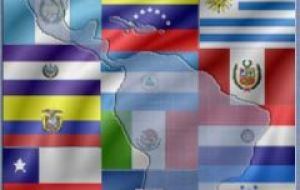MercoPress. South Atlantic News Agency
Latinamerica “business climate” steady and in “cautious boom” phase
 FGV is one of Latam’s leading think tank and research centres
FGV is one of Latam’s leading think tank and research centres Chile, Peru and Uruguay rank as the countries with the best business climate according to a report from the Brazilian foundation Getulio Vargas, FGV. The October report released this week ranks Chile with 7.5 points; Peru, 7.1; Uruguay, 7; Brazil, 6.8; Colombia, 6.8; Paraguay, 6.5; Argentina, 5.9 and Bolivia, 5.6.
Countries outside of what is considered the positive area include: Mexico, 5.2 (down from 6.3 in July); Ecuador, 5.2 and Venezuela, 2.5. The report also points out that business-climate suffered an erosion between July and October in Brazil, Colombia, Mexico, Paraguay, Peru and Uruguay.
“But in spite of the results, Brazil, Colombia, Peru and Uruguay remain in the ‘boom’ phase. Mexico and Paraguay on the other hand have lost that condition”.
The business climate index between July/October advanced in Argentina, Bolivia, Ecuador and Venezuela, even when these countries remain in what are described as declining, recovering or recession phases.
The countries which most advanced in their rankings in the July/October period are Bolivia and Ecuador from 4.6 and 4.2 to 5.6 and 5.2 respectively.
However the overall business climate in Latinamerica that in July was at its apex of the decade, lost thrust in October because of a cautious approach towards future events, points out the FGV report.
The overall Business Climate index dropped from 6 points in July to 5.8 in October, which also signals the first fall back of the index since January 2009 when it was at its lowest ever, 2.9 because of the world crisis, points out FGV.
Since then is has expanded sustainedly having reached 5.6 points last April and 6 in July, similar to April 2000 and only below the all time record of 6.3 in 1997.
The Business Climate Index polls 149 experts in 17 countries of the region and is the mix of two components: Current Situation index (ISA) and the Expectations index (IE).
The third quarter slowdown can be attributed to a higher uncertainty in countries of the region regarding the future, since the whole area has moved steadily forward. While ISA remained stable at 5.8 points, the IE dropped from 6.2 in July to 5.8 in October.
“With the ISA and IE at their highest above the average of the last ten years, the economic cycle in the region remains in the economic ‘boom’ phase”, says the report.
But since this quarter marks the third consecutive drop of the IE, the Latinamerican situation is described as “cautious boom”, which nevertheless reflects the world economic climate which dropped from 5.7 in July to 5.5 in October
The worsening of expectations has been greater in Latinamerica, which comes to confirm the prevalence of a climate of uncertainty at world level and of a slow economic recovery.
FGV points out that the report was finished before the current “currencies war” and its repercussions, as well as of the Seoul G-20 and its lack of any formal advances or commitments. Thus “the cloudy and possible turbulence forecast for the coming months”.
The FGV reports are compiled together with Germany’s Munich University’s Economic Research Institute, IFO, which elaborates the European and global indexes.




Top Comments
Disclaimer & comment rulesCommenting for this story is now closed.
If you have a Facebook account, become a fan and comment on our Facebook Page!